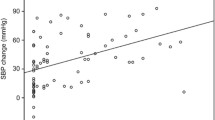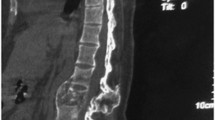Abstract
Purpose
The aim of this study was to investigate the influence of the initial American Spinal Injury Association Impairment Scale (AIS) category and the conversion rate in acute traumatic tetraplegic patients on the development of heterotopic ossifications (HO). The second objective was to prove the hypothesis that tetraplegic patients with autonomic dysreflexia (AD) develop HO more often than patients without AD.
Methods
A retrospective analysis from 2002 to 2009 of 330 patients with spinal cord injuries was performed and led to the inclusion of 77 traumatic tetraplegic patients. Clinical data was reviewed to determine the appearance of HO (n = 8) and its possible coincidence with AD during urodynamics. Spearman’s correlation coefficient was calculated to test the relationship between HO and initial AIS category or the change in AIS category within 6 weeks. A matched pair (age, neurological level of injury) analysis of two samples (n = 8 with/without appearance of HO; total n = 16) was performed.
Results
The appearance of HO was significantly correlated with an initial AIS A compared to incomplete tetraplegia at baseline (p < 0.017). The conversion of AIS A into incomplete tetraplegia was highly correlated with the incidence of HO (p < 0.003). AD showed a positive correlation with HO (r = 0.97, p = 0.001).
Conclusions
An initial AIS A that converts early into an incomplete tetraplegia constitutes a risk factor for the development of HO. Additionally, AD constitutes an important trigger in the development of HO in acute traumatic tetraplegic patients.


Similar content being viewed by others
References
Dejerne A, Ceiller A. Para-osteo-arthropathies des paraplegiques par lesion medullaire: etude clinique et radiologique. Ann Med. 1918;5:497.
Blackmer J. Rehabilitation medicine, 1: autonomic dysreflexia. CMAJ. 2003;169:931–5.
Vanden Bossche L, Vanderstraeten G. Heterotopic ossification: a review. J Rehabil Med. 2005;37(3):129–36.
Catz A, Snir D, Groswasser Z, Mendelson L, Solzi P. Is the appearance of periarticular new bone formation related to local neurological disability? Paraplegia. 1992;30(5):361–5.
Marino RJ. International standards for neurological and functional classification of spinal cord injury. Chicago: American Spinal Injury Association; 2000.
Dolinak D, Balraj E. Autonomic dysreflexia and sudden death in people with traumatic spinal cord injury. Am J Forensic Med Pathol. 2007;28(2):95–8.
Curt A, Nitsche B, Rodic B, Schurch B, Dietz V. Assessment of autonomic dysreflexia in patients with spinal cord injury. J Neurol Neurosurg Psychiatry. 1997;62:473–7.
Krassioukov AV, Furlan JC, Fehlings MG. Autonomic dysreflexia in acute spinal cord injury: an under-recognized clinical entity. J Neurotrauma. 2003;20:707–16.
Schottler J, Vogel L, Chafetz R, Mulcahey MJ. Patient and caregiver knowledge of autonomic dysreflexia among youth with spinal cord injury. Spinal Cord. 2009;47:681–6.
Cipriano CA, Pill SG, Keenan MA. Heterotopic ossification following traumatic brain injury and spinal cord injury. J Am Acad Orthop Surg. 2009;17(11):689–97.
Eggli S, Woo A. Risk factors for heterotopic ossification in total hip arthroplasty. Arch Orthop Trauma Surg. 2001;121(9):531–5.
Siemers F, Lohmeyer JA, Machens HG, Eisenbeiss W, Mailänder P. Heterotopic ossifications: a severe complication following extensive burn injury. Handchir Mikrochir Plast Chir. 2007;39(5):360–3.
Akbar M, Seyler TM, Abel R, Gerner HJ. Heterotopic ossification in spinal cord injury and traumatic brain injury. Phys Med Rehabil Kuror. 2007;17:156–71.
Hernandez AM, Forner JV, de la Fuente T, Gonzalez C, Miro R. The para-articular ossifications on our paraplegics and tetraplegics. A survey of 704 patients. Paraplegia. 1978;16:272–5.
van Kuijk AA, Geurts ACH, van Kuppevelt HJM. Neurogenic heterotopic ossification in spinal cord injury. Spinal Cord. 2002;40:313–26.
Weaver LC. What causes autonomic dysreflexia after spinal cord injury? Clin Auton Res. 2002;12(6):424–6.
Spiess MR, Müller RM, Rupp R, Schuld C, EM-SCI Study Group, van Hedel HJ. Conversion in ASIA impairment scale during the first year after traumatic spinal cord injury. J Neurotrauma. 2009;26:2027–36.
Alexander MS, Biering-Sorensen F, Bodner D, Brackett NL, Cardenas D, Charlifue S, et al. International standards to document remaining autonomic function after spinal cord injury. Spinal Cord. 2009;47:36–43.
Weaver LC, Marsh DR, Gris D, Brown A, Dekaban GA. Autonomic dysreflexia after spinal cord injury: central mechanisms and strategies for prevention. Prog Brain Res. 2006;152:245–63.
Lemke DM. Sympathetic storming after severe traumatic brain injury. Crit Care Nurse. 2007;27(1):30–7.
Svircev JN, Wallbom AS. False-negative triple-phase bone scans in spinal cord injury to detect clinically suspect heterotopic ossification: a case series. J Spinal Cord Med. 2008;31(2):194–6.
Acknowledgments
In memory of my mother.
Conflict of interest
C. Putz, L. Helbig, H. J. Gerner, M. Zimmermann-Stenzel and M. Akbar declare that they have no conflict of interest.
Compliance with Ethics Guidelines
This study was approved by the ethics committee. This article does not contain any studies with human or animal subjects performed by the any of the authors.
Author information
Authors and Affiliations
Corresponding author
Rights and permissions
About this article
Cite this article
Putz, C., Helbig, L., Gerner, H.J. et al. Autonomic dysreflexia: a possible trigger for the development of heterotopic ossifications after traumatic spinal cord injury?. Eur J Trauma Emerg Surg 40, 721–726 (2014). https://doi.org/10.1007/s00068-013-0353-8
Received:
Accepted:
Published:
Issue Date:
DOI: https://doi.org/10.1007/s00068-013-0353-8




